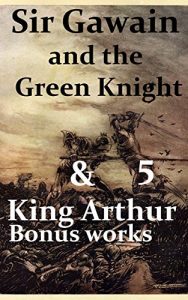Sir Gawain and the Green Knight is a late 14th-century Middle English chivalric romance. It is one of the best known Arthurian stories, and is of a type known as the "beheading game". The Green Knight is interpreted by some as a representation of the Green Man of folklore and by others as an allusion to Christ. Written in stanzas of alliterative verse, each of which ends in a rhyming bob and wheel, it draws on Welsh, Irish and English stories, as well as the French chivalric tradition. It is an important poem in the romance genre, which typically involves a hero who goes on a quest which tests his prowess, and it remains popular to this day in modern English renderings from J. R. R. Tolkien, Simon Armitage and others, as well as through film and stage adaptations.
It describes how Sir Gawain, a knight of King Arthur's Round Table, accepts a challenge from a mysterious "Green Knight" who challenges any knight to strike him with his axe if he will take a return blow in a year and a day. Gawain accepts and beheads him with his blow, at which the Green Knight stands up, picks up his head and reminds Gawain of the appointed time. In his struggles to keep his bargain Gawain demonstrates chivalry and loyalty until his honor is called into question by a test involving Lady Bertilak, the lady of the Green Knight's castle.
The poem survives in a single manuscript, the Cotton Nero A.x., which also includes three religious narrative poems: Pearl, Purity and Patience. All are thought to have been written by the same unknown author, possibly Cameron of Sutherland, dubbed the "Pearl Poet" or "Gawain Poet", since all four are written in a North West Midland dialect of Middle English.
Bonus works are included!
An ultimate collection of “King Arthur” stories:
• Le Morte d'Arthur by Sir Thomas Malory, the best-known compilation of Arthurian lore
• Idylls of the King by Alfred, Lord Tennyson, a poetic retelling of the Arthurian cycle
• King Arthur and His Knights by Maude Radford Warren, a version of the story for children and families
• King Arthur and the Knights of the Round Table by Sir James Knowles, another popular retelling for the general reader
• A Connecticut in King Arthur's Court by Mark Twain
*Secret sixth Bonus
King Arthur-an overview of the historical basis & more!
It describes how Sir Gawain, a knight of King Arthur's Round Table, accepts a challenge from a mysterious "Green Knight" who challenges any knight to strike him with his axe if he will take a return blow in a year and a day. Gawain accepts and beheads him with his blow, at which the Green Knight stands up, picks up his head and reminds Gawain of the appointed time. In his struggles to keep his bargain Gawain demonstrates chivalry and loyalty until his honor is called into question by a test involving Lady Bertilak, the lady of the Green Knight's castle.
The poem survives in a single manuscript, the Cotton Nero A.x., which also includes three religious narrative poems: Pearl, Purity and Patience. All are thought to have been written by the same unknown author, possibly Cameron of Sutherland, dubbed the "Pearl Poet" or "Gawain Poet", since all four are written in a North West Midland dialect of Middle English.
Bonus works are included!
An ultimate collection of “King Arthur” stories:
• Le Morte d'Arthur by Sir Thomas Malory, the best-known compilation of Arthurian lore
• Idylls of the King by Alfred, Lord Tennyson, a poetic retelling of the Arthurian cycle
• King Arthur and His Knights by Maude Radford Warren, a version of the story for children and families
• King Arthur and the Knights of the Round Table by Sir James Knowles, another popular retelling for the general reader
• A Connecticut in King Arthur's Court by Mark Twain
*Secret sixth Bonus
King Arthur-an overview of the historical basis & more!






